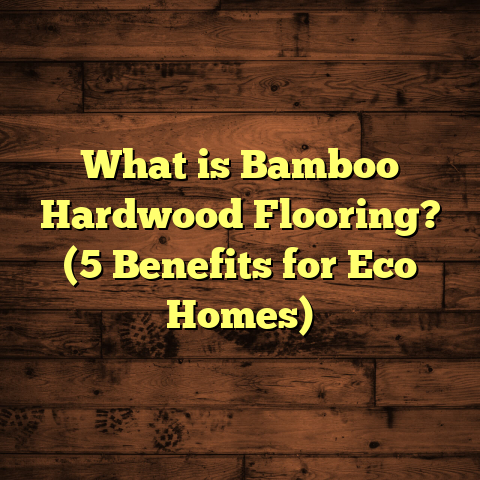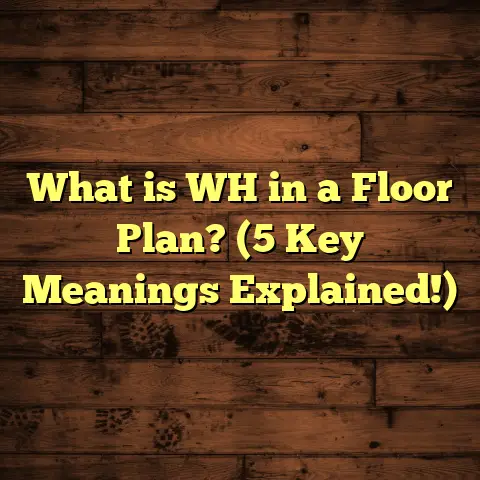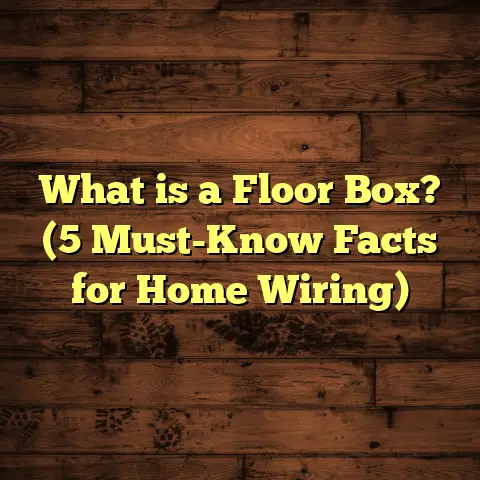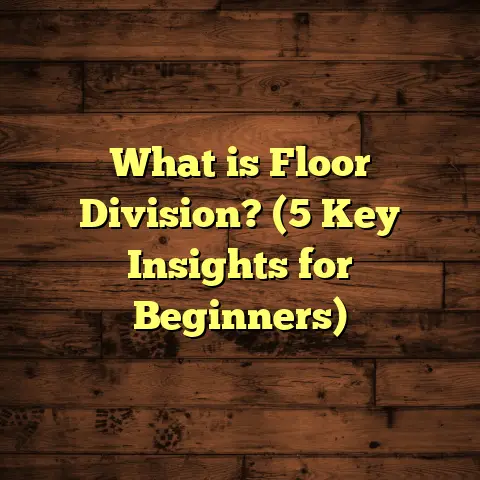What is the Average Price for Hardwood Floor Installation? (5 Key Factors)
What Is the Average Price for Hardwood Floor Installation?
If you’ve ever thought about installing hardwood floors in your home, you’ve probably asked yourself: “How much will this cost?” It’s one of those questions that’s simple to ask but tricky to answer. I get it — hardwood floors are a big investment. When I first started working as a flooring contractor, I had clients who expected a straightforward price per square foot. But after years of experience, I know there’s a lot more to it than just a number.
Let’s talk about what really affects hardwood floor installation costs. I’ll share my personal stories from the field, real data, and insights that most people don’t get until they’re already knee-deep in renovation. By the time you finish reading, you’ll have a clear understanding of why prices vary so much and what to expect for your own project.
What Exactly Is Hardwood Floor Installation?
Hardwood floor installation means laying down actual wood planks or boards to create a lasting floor surface in your home. This isn’t the same as laminate or vinyl flooring, which just mimic the look of wood. Hardwood floors are made from real wood — either solid pieces or engineered layers with a wood veneer.
When I say “installation,” I mean everything from preparing the subfloor to the final finish coat. It’s not just throwing down some planks and calling it done. Depending on your home’s condition and the type of hardwood you choose, installation can be a straightforward job or a complex process that takes several days.
You might be wondering, “What types of hardwood are there?” Here’s the quick rundown:
- Solid Hardwood: These are planks made from one solid piece of wood, usually about ¾ inch thick. They can be sanded and refinished multiple times over their lifespan.
- Engineered Hardwood: These have a thin layer of real wood on top bonded to plywood or composite layers underneath. They’re often easier to install and more stable in humid conditions.
Each type has unique installation methods: nail-down, glue-down, or floating. These methods affect labor costs and time.
I remember working on a project where the client wanted solid oak floors installed in their living room. The wood was beautiful but heavy and had to acclimate in the house for a week before installation. That waiting time added to the overall project duration—and cost.
5 Key Factors That Affect Hardwood Floor Installation Price
1. Type of Hardwood Flooring: More Than Just Wood
When people think about hardwood floors, they often imagine “wood” as one thing. But hardwood comes in countless species and grades — and each one affects price.
Domestic vs. Exotic Woods
Domestic hardwoods like oak, maple, and hickory usually cost less than exotic species such as Brazilian cherry, teak, or mahogany.
- Oak: One of the most common hardwoods, oak is durable and affordable.
- Maple: Slightly harder than oak with a fine grain.
- Walnut: A darker wood with a rich look that commands a higher price.
- Exotic woods: These are pricier due to scarcity and shipping costs.
From my experience, exotic woods can cost twice as much as oak per square foot. For example, Brazilian cherry can run $8–$12 per sq ft for materials alone.
Solid vs. Engineered Hardwood
Solid hardwood tends to be pricier because it’s thicker and can be refinished more times. Engineered hardwood is often less expensive upfront but might have a shorter lifespan.
When I started out, I worked on an engineered floor installation in a coastal home prone to humidity fluctuations. The client chose engineered because solid hardwood would have warped in that environment—so sometimes price is about matching the right product to your space.
Grade of Wood
Wood grades refer to appearance: clear grade has fewer knots and blemishes; rustic grade includes more character marks.
I once installed rustic-grade pine floors in a cabin where the natural knots added charm and saved the client about 25% compared to clear-grade pine.
2. Installation Method and Labor Costs: It’s Not Just Laying Planks
Installing hardwood is labor-intensive work. The method you choose plays a big role in pricing.
Nail-Down Installation
This traditional method works best for solid hardwood over plywood subfloors. It’s sturdy but requires experience to avoid damaging planks.
Labor cost generally runs $3–$5 per sq ft for nail-down jobs.
Glue-Down Installation
Common with engineered hardwood on concrete slabs or existing subfloors that can’t be nailed into. Glue-down requires special adhesives applied carefully.
Labor cost here is roughly $4–$7 per sq ft because it requires more prep and drying time.
Floating Floors
Engineered hardwood often uses floating installation where planks snap together and aren’t attached directly to the subfloor.
This is usually the cheapest labor option at $2–$4 per sq ft.
My Experience With Labor Variability
I once quoted two similar-sized jobs side-by-side—one was on the first floor with easy access; the other was on the third floor with narrow stairs and no elevator. The upstairs job cost nearly 30% more in labor due to difficulties moving materials.
Why Labor Costs Vary Regionally
In cities like New York or San Francisco, labor rates can be double what they are in smaller towns due to higher living costs and demand.
3. Room Size and Shape: Why Bigger Isn’t Always Cheaper
You might assume bigger rooms lower your per-square-foot cost because installers don’t have to move equipment as much.
But oddly shaped rooms or spaces with lots of corners can increase installation time significantly.
I worked on a historic home with intricate molding and curved walls where each plank needed custom cuts. That project took twice as long as a square room of the same size.
Small rooms under 200 sq ft sometimes cost more per square foot because setup time remains constant regardless of size.
Example Pricing Impact
- Rectangular 600 sq ft room: $10 per sq ft installed
- Irregular 600 sq ft room with lots of cuts: $13 per sq ft installed
4. Subfloor Condition and Preparation: The Hidden Cost No One Talks About
One of the biggest surprises for homeowners is how much subfloor prep can add to costs.
If your subfloor is:
- Uneven
- Damaged
- Moisture-compromised
- Covered with old flooring that needs removal
You’ll need extra work before installing hardwood.
Removing Old Flooring
Carpet removal might cost $1–$2 per sq ft; tile removal can be $3–$5 per sq ft due to difficulty.
Subfloor Repair
Patching holes or replacing plywood can add $2–$4 per sq ft.
Leveling
Self-leveling compounds or sanding may be required if floors aren’t flat within acceptable tolerance (usually 3/16 inch over 10 feet).
I had a client with water damage under old vinyl tile who had to replace half the plywood sheathing—not cheap but necessary for success.
Moisture Barriers
In basements or slabs on grade, moisture barriers like plastic sheets or sealants are often installed to protect wood—costing $0.50–$1 per sq ft extra.
5. Finishing Options: More Choices Than You Think
Hardwood floors can come prefinished or unfinished:
- Prefinished floors are sanded, stained, and sealed at the factory.
- Unfinished floors are installed raw and finished onsite with stain, sealant, or oil.
Prefinished saves time but limits customization options; onsite finishing lets you choose color and sheen but adds labor.
Costs for Finishing
On-site finishing typically adds $3–$5 per sq ft including sanding, staining, and sealing.
In one memorable job, a client wanted a custom blue-gray stain on unfinished white oak—a rare request that meant several coats of stain and sealant plus days of drying time.
Some opt for oils instead of polyurethane for a natural look but oils require more frequent maintenance.
Digging Deeper: Additional Factors Influencing Price
Wood Plank Width and Length
Wider planks (over 5 inches) tend to cost more than narrow strips because they come from larger trees and are harder to produce without defects.
Longer boards also command premium prices due to fewer seams and a more elegant look.
A client once chose wide-plank hickory floors for their rustic lodge-style home—it cost about 20% more than standard strip oak but fit their aesthetic perfectly.
Patterns and Layouts
Simple straight plank layouts are cheapest, but if you want herringbone, chevron, or parquet patterns expect additional labor charges (20–40% more).
I installed herringbone flooring in a boutique store last year—it took twice as long as regular plank installation because we had to cut and place each piece precisely.
Room Accessibility and Removal Costs
If your home has narrow staircases or tight spaces making it hard to bring in materials, labor time goes up.
Also consider disposal fees for old flooring—some municipalities charge extra for construction debris removal.
Average Price Breakdown: Real Numbers From Projects
Based on my recent projects across multiple states and data from industry reports:
| Item | Low End ($/sq ft) | High End ($/sq ft) | Typical Range ($/sq ft) |
|---|---|---|---|
| Materials (Wood) | 4 | 12 | 6 – 9 |
| Labor Installation | 3 | 8 | 4 – 6 |
| Subfloor Prep | 0 | 4 | 1 – 2 |
| Finishing (if onsite) | 0 | 5 | 2 – 4 |
| Removal of old flooring | 0 | 5 | 1 – 3 |
Consider this example:
700 sq ft mid-range project
- Materials (engineered oak): $7 × 700 = $4,900
- Labor installation (floating): $3 × 700 = $2,100
- Subfloor prep (minimal): $1 × 700 = $700
- Finishing (prefinished): $0
Total: $7,700 or about $11 per sq ft
Personal Stories From The Field
Story #1: The Unexpected Subfloor Surprise
I was installing hardwood in an older home when we lifted carpet in one room only to find rotten plywood underneath caused by decades-old leaks. The repair added weeks and thousands of dollars but was necessary for a quality finish.
The takeaway? Always budget for surprises!
Story #2: Choosing Engineered Hardwood for Moisture-Prone Areas
A client near coastal Florida wanted wood floors throughout their beach house. I recommended engineered hardwood because solid wood would warp in humidity.
We installed glue-down engineered planks designed for moisture resistance at a slightly higher material cost but avoided future headaches.
How Hardwood Floor Installation Compares To Other Flooring Types
Knowing how hardwood stacks up against other options helps put costs into perspective:
| Flooring Type | Installed Cost/sq ft | Lifespan (Years) | Maintenance | Resale Value Impact |
|---|---|---|---|---|
| Solid Hardwood | $8 – $20 | 30+ | Moderate | High |
| Engineered Hardwood | $6 – $14 | 20+ | Moderate | Moderate |
| Laminate | $3 – $8 | 10 – 15 | Low | Low |
| Vinyl Plank | $2 – $7 | 15 – 20 | Low | Low |
| Carpet | $3 – $10 | 5 – 15 | High | Low |
| Ceramic Tile | $5 – $15 | 25+ | Moderate | Moderate |
Hardwood floors generally cost more upfront but last longer and increase home value significantly if maintained well.
How To Budget Smartly For Hardwood Floor Installation
Based on what I’ve seen over the years:
- Get multiple quotes including material and labor breakdowns
- Factor in extra for subfloor prep—at least 10–15% contingency
- Decide early on finish type: prefinished saves time but onsite finishing offers custom looks
- Consider waste factor (usually add about 5–10% over room size)
- Don’t forget removal fees if replacing existing flooring
Using tools like FloorTally can help you run through all these factors with current local pricing so you’re not caught off guard later.
Wrapping Up My Thoughts
Hardwood floor installation costs depend on many moving parts—from your choice of wood species to subfloor condition to finishing options.
Over time I’ve learned that transparency with clients about these variables upfront helps everyone avoid surprises—and leads to better satisfaction with the final floor.
If you’re weighing hardwood against laminate or vinyl, think about how long you plan to stay in your home. Hardwood is expensive upfront but pays off if you want durability, timeless style, and resale value.
I’m always happy to answer specific questions based on your project details—just ask!
If you want me to expand any section further or add more case studies or technical details, just say so!





